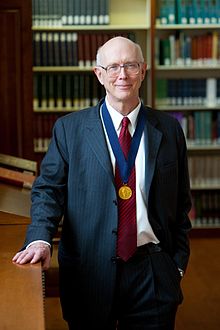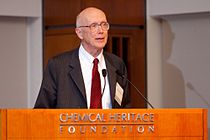George M. Whitesides
| George McClelland Whitesides |

George M. Whitesides, 2010
|
| Born |
(1939-08-03) August 3, 1939 (age 77)
Louisville, Kentucky, U.S.
|
| Residence |
U.S. |
| Nationality |
American |
| Fields |
chemistry, nanotechnology
|
| Institutions |
Harvard University
Massachusetts Institute of Technology
|
| Alma mater |
Harvard University
California Institute of Technology
|
| Thesis |
The configurational stability of primary Grignard reagents. Applications of nuclear magnetic resonance spectroscopy to the study of molecular asymmetry (1964)
|
| Doctoral advisor |
John D. Roberts |
| Doctoral students |
Craig L. Hill, Chi-Huey Wong, Younan Xia
|
| Known for |
The Corey-House-Posner-Whitesides reaction
Contributions in the fields of NMR spectroscopy, organometallic chemistry, molecular self-assembly, soft lithography,microfabrication, microfluidics, and nanotechnology. |
| Notable awards |
ACS Award in Pure Chemistry (1975)
Arthur C. Cope Award (1995)
National Medal of Science (1998)
Kyoto Prize (2003)
Dan David Prize (2005)
Linus Pauling Award (2005)
Priestley Medal (2007)
R&D Magazine – Scientist of the Year (2007)
Othmer Gold Medal (2010)
King Faisal International Prize (2011)
IRI Medal (2013)
|
External video
 |
 Publishing Your Research 101 Impact of technology on scientific articles, George Whitesides, American Chemical Society, April 29, 2011 Publishing Your Research 101 Impact of technology on scientific articles, George Whitesides, American Chemical Society, April 29, 2011 |
 Zero cost diagnostics George Whitesides, TEDxBoston, August 10, 2009 Zero cost diagnostics George Whitesides, TEDxBoston, August 10, 2009 |
 Toward a science of simplicity, George Whitesides, TED, April 29, 2010 Toward a science of simplicity, George Whitesides, TED, April 29, 2010 |
 Talking Nano: Perspectives on Nanotechnology (1 of 4), George Whitesides, Museum of Science, Boston, October 26, 2007 Talking Nano: Perspectives on Nanotechnology (1 of 4), George Whitesides, Museum of Science, Boston, October 26, 2007 |
 The Courage to Go Off and Start New Things, George Whitesides, Chemical Heritage Foundation, June 17, 2010 The Courage to Go Off and Start New Things, George Whitesides, Chemical Heritage Foundation, June 17, 2010 |
ACS Award in Pure Chemistry (1975)
Arthur C. Cope Award (1995)
National Medal of Science (1998)
Kyoto Prize (2003)
Dan David Prize (2005)
Linus Pauling Award (2005)
Priestley Medal (2007)
R&D Magazine – Scientist of the Year (2007)
Othmer Gold Medal (2010)
King Faisal International Prize (2011)
IRI Medal (2013)
George M. Whitesides (born August 3, 1939) is an American chemist and professor of chemistry at Harvard University. He is best known for his work in the areas of NMR spectroscopy, organometallic chemistry, molecular self-assembly, soft lithography,microfabrication, microfluidics, and nanotechnology. A prolific author and patent holder who has received many awards, he received the highest Hirsch index rating of all living chemists in 2011.
Whitesides attended secondary school at Phillips Andover and graduated in 1957. He received his A.B. degree from Harvard College in 1960 and earned a Ph.D. in chemistry from the California Institute of Technology in 1964, where he worked with John D. Roberts. At Caltech, Whitesides began working in organic chemistry. Whitesides' graduate work in organometallic chemistry used NMR spectroscopy and density matrices to study Grignard reagents. He used NMR spectroscopy to study rate of change of Grignard reagents and the structure of Grignard reagents in solution. He also studied spin-spin coupling in a variety of organic compounds, using density matrix calculations to examine the spin systems that NMR analyses detect.
...
Wikipedia


